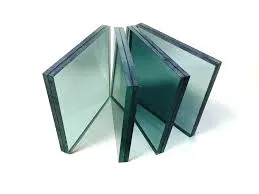The Advantages and Applications of Tinted and Reflective Glass
Glass has long been a staple material in architecture and design, offering functionality combined with aesthetic appeal. Among the various types of glass available, tinted and reflective glass stands out due to its numerous advantages and diverse applications. These specialized forms of glass not only enhance the visual appeal of buildings but also play crucial roles in energy efficiency and privacy.
What is Tinted Glass?
Tinted glass is produced by adding metal oxides to the glass during the manufacturing process, which alters its color and light transmission properties. The tint can vary in shade, from light to dark, and can include shades such as bronze, gray, green, and blue. The main purpose of tinted glass is to reduce glare and control solar heat gain, making spaces more comfortable while offering a significant reduction in UV radiation that can damage furnishings and fabrics.
One of the primary benefits of tinted glass is its ability to improve energy efficiency. By reducing the amount of solar heat that enters a building, tinted glass can lower cooling costs, thus contributing to overall energy savings. This not only benefits the environment but also results in economic advantages for homeowners and businesses alike. Additionally, tinted glass can enhance the privacy of indoor spaces without sacrificing natural light, allowing occupants to enjoy their surroundings with less concern about being seen from the outside.
What is Reflective Glass?
Reflective glass, on the other hand, features a metallic coating that gives it a mirror-like appearance. This coating reflects sunlight away from the building, making it an effective solution for heat control and glare reduction. Like tinted glass, reflective glass can help maintain a comfortable indoor environment and minimize energy consumption.
The aesthetic appeal of reflective glass is significant as well. It can create striking architectural features while providing a modern, sleek appearance. This type of glass is commonly used in commercial buildings where aesthetics play a crucial role in attracting clientele. Reflective glass can also contribute to enhancing the views of city skylines or natural landscapes, offering occupants an engaging experience without compromising their comfort.
tinted and reflective glass
Applications in Modern Architecture
Both tinted and reflective glass are widely used in various architectural applications, from residential buildings to skyscrapers and commercial facilities. In office buildings, for instance, reflective glass can create an impressive façade while providing employees with a comfortable working environment. Furthermore, using these types of glass in large windows or curtain walls can maximize natural light while minimizing heat gain.
In residential settings, homeowners often opt for tinted windows to enhance privacy and reduce glare in living areas. This choice not only improves comfort but also adds a layer of protection for furniture and decor from UV damage.
Moreover, safety is another consideration that often brings architectural professionals to choose tinted or reflective glass. Both types of glass can be treated to increase resistance to breakage, making them ideal for high-traffic areas or regions prone to storms.
Environmental Considerations
As the world becomes more eco-conscious, the demand for energy-efficient building materials continues to rise. Tinted and reflective glass align with these sustainability goals by decreasing reliance on air conditioning systems and reducing overall energy consumption. Furthermore, their longevity and durability contribute to lower maintenance costs over time, reinforcing the case for their use in modern construction.
In conclusion, tinted and reflective glass provide an array of benefits that extend beyond mere aesthetics. They enhance energy efficiency, privacy, and safety while contributing to the design and functionality of modern architecture. As building standards evolve and environmental considerations grow increasingly important, the role of tinted and reflective glass in architectural design will only become more significant, paving the way for smarter, more sustainable buildings.
 Afrikaans
Afrikaans  Albanian
Albanian  Amharic
Amharic  Arabic
Arabic  Armenian
Armenian  Azerbaijani
Azerbaijani  Basque
Basque  Belarusian
Belarusian  Bengali
Bengali  Bosnian
Bosnian  Bulgarian
Bulgarian  Catalan
Catalan  Cebuano
Cebuano  Corsican
Corsican  Croatian
Croatian  Czech
Czech  Danish
Danish  Dutch
Dutch  English
English  Esperanto
Esperanto  Estonian
Estonian  Finnish
Finnish  French
French  Frisian
Frisian  Galician
Galician  Georgian
Georgian  German
German  Greek
Greek  Gujarati
Gujarati  Haitian Creole
Haitian Creole  hausa
hausa  hawaiian
hawaiian  Hebrew
Hebrew  Hindi
Hindi  Miao
Miao  Hungarian
Hungarian  Icelandic
Icelandic  igbo
igbo  Indonesian
Indonesian  irish
irish  Italian
Italian  Japanese
Japanese  Javanese
Javanese  Kannada
Kannada  kazakh
kazakh  Khmer
Khmer  Rwandese
Rwandese  Korean
Korean  Kurdish
Kurdish  Kyrgyz
Kyrgyz  Lao
Lao  Latin
Latin  Latvian
Latvian  Lithuanian
Lithuanian  Luxembourgish
Luxembourgish  Macedonian
Macedonian  Malgashi
Malgashi  Malay
Malay  Malayalam
Malayalam  Maltese
Maltese  Maori
Maori  Marathi
Marathi  Mongolian
Mongolian  Myanmar
Myanmar  Nepali
Nepali  Norwegian
Norwegian  Norwegian
Norwegian  Occitan
Occitan  Pashto
Pashto  Persian
Persian  Polish
Polish  Portuguese
Portuguese  Punjabi
Punjabi  Romanian
Romanian  Russian
Russian  Samoan
Samoan  Scottish Gaelic
Scottish Gaelic  Serbian
Serbian  Sesotho
Sesotho  Shona
Shona  Sindhi
Sindhi  Sinhala
Sinhala  Slovak
Slovak  Slovenian
Slovenian  Somali
Somali  Spanish
Spanish  Sundanese
Sundanese  Swahili
Swahili  Swedish
Swedish  Tagalog
Tagalog  Tajik
Tajik  Tamil
Tamil  Tatar
Tatar  Telugu
Telugu  Thai
Thai  Turkish
Turkish  Turkmen
Turkmen  Ukrainian
Ukrainian  Urdu
Urdu  Uighur
Uighur  Uzbek
Uzbek  Vietnamese
Vietnamese  Welsh
Welsh  Bantu
Bantu  Yiddish
Yiddish  Yoruba
Yoruba  Zulu
Zulu 

